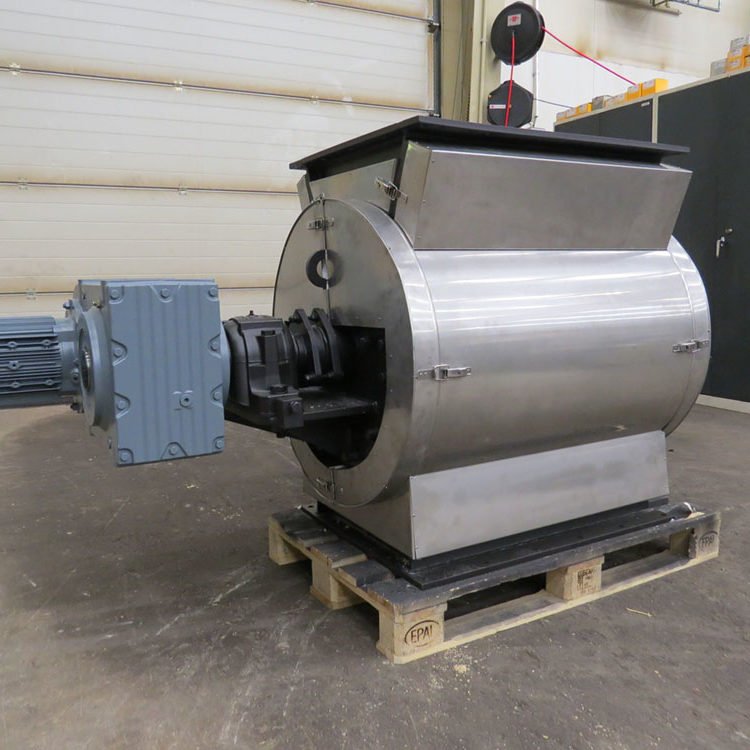Rotary valves are essential components in various industrial processes, particularly in material handling and pneumatic conveying systems. They serve multiple functions, including controlling the flow of materials, maintaining a controlled atmosphere, and ensuring dust-free operations. This article delves into the different types of rotary valves available, providing a comprehensive understanding of their applications and benefits.
Standard Rotary Valves
Standard rotary valves are the most commonly used type in industrial applications. These valves are designed to handle a wide range of materials, from fine powders to granular substances. They consist of a rotor with multiple vanes that rotate within a housing, allowing for the controlled discharge of materials from hoppers, bins, or silos.
One of the primary advantages of standard rotary valves is their versatility. They can be used in various industries, including cement, minerals, and battery chemicals. Additionally, these valves are known for their robust construction, which ensures reliable performance even in demanding environments. The design of standard rotary valves also allows for easy maintenance, making them a cost-effective solution for many applications.
Blow-Through Rotary Valves
Blow-through rotary valves are specifically designed for pneumatic conveying systems. Unlike standard rotary valves, blow-through valves have an additional air inlet that allows air to pass through the rotor pockets, facilitating the efficient transfer of materials into the conveying line. This design minimizes material build-up and ensures a consistent flow rate.
These valves are particularly useful in applications where materials tend to be sticky or prone to caking. The blow-through design helps to prevent blockages and maintain a smooth flow of materials. Additionally, blow-through rotary valves are often used in high-pressure conveying systems, where maintaining a controlled atmosphere is crucial for process efficiency and safety.
Drop-Through Rotary Valves
Drop-through rotary valves, also known as gravity-fed rotary valves, are designed for applications where materials are fed by gravity. These valves are typically used in low-pressure systems and are ideal for handling free-flowing materials. The drop-through design allows materials to fall directly into the rotor pockets, which then discharge them into the downstream process.
One of the key benefits of drop-through rotary valves is their simplicity. The straightforward design makes them easy to install and maintain, reducing downtime and operational costs. Additionally, these valves are well-suited for applications where maintaining a controlled atmosphere is not a primary concern, such as in bulk material handling and storage systems.
Airlock Rotary Valves
Airlock rotary valves are designed to maintain a controlled atmosphere by preventing air leakage between different stages of a process. These valves are commonly used in pneumatic conveying systems, where maintaining pressure differentials is essential for efficient material transfer. The airlock design ensures that materials are discharged while minimizing air leakage, which helps to maintain system efficiency and reduce energy consumption.
Airlock rotary valves are particularly beneficial in applications where dust control is critical. The sealed design helps to prevent dust from escaping into the environment, ensuring a cleaner and safer workspace. Additionally, these valves are often used in high-temperature applications, where maintaining a controlled atmosphere is essential for process stability and product quality.
High-Temperature Rotary Valves
High-temperature rotary valves are specifically designed to handle materials at elevated temperatures. These valves are constructed from heat-resistant materials and feature specialized seals and bearings that can withstand extreme temperatures. High-temperature rotary valves are commonly used in industries such as metallurgy, where materials are often processed at high temperatures.
One of the primary advantages of high-temperature rotary valves is their ability to maintain performance and reliability under challenging conditions. The robust construction ensures that the valves can handle thermal expansion and contraction without compromising their sealing capabilities. Additionally, these valves are designed to minimize heat transfer to the surrounding environment, ensuring safe and efficient operation.
Wear-Resistant Rotary Valves
Wear-resistant rotary valves are designed for applications where materials are abrasive or cause significant wear on standard valve components. These valves are constructed from wear-resistant materials, such as hardened steel or ceramic, and feature reinforced rotor vanes and housing. Wear-resistant rotary valves are commonly used in industries such as mining and minerals processing, where materials can be highly abrasive.
The primary benefit of wear-resistant rotary valves is their extended service life. The durable construction ensures that the valves can withstand the rigors of handling abrasive materials, reducing the frequency of maintenance and replacement. Additionally, these valves are designed to maintain a tight seal, even under harsh conditions, ensuring reliable performance and minimizing downtime.
Sanitary Rotary Valves
Sanitary rotary valves are designed for applications where hygiene and cleanliness are paramount. These valves are constructed from stainless steel and feature smooth, polished surfaces that are easy to clean and sanitize. Sanitary rotary valves are commonly used in industries such as food processing and pharmaceuticals, where maintaining product purity is essential.
One of the key advantages of sanitary rotary valves is their compliance with stringent hygiene standards. The design minimizes crevices and dead spaces where contaminants can accumulate, ensuring that the valves can be thoroughly cleaned and sanitized. Additionally, these valves are often equipped with quick-release mechanisms that allow for easy disassembly and reassembly, further enhancing their suitability for hygienic applications.
Conclusion
Rotary valves play a crucial role in various industrial processes, offering a range of solutions for material handling and pneumatic conveying systems. From standard rotary valves to specialized designs such as blow-through, drop-through, airlock, high-temperature, wear-resistant, and sanitary rotary valves, each type offers unique benefits tailored to specific applications. Understanding the different types of rotary valves available can help industries select the most suitable solution for their needs, ensuring efficient and reliable operation.
By exploring the various types of rotary valves, industries can make informed decisions that enhance their processes, improve efficiency, and maintain a controlled atmosphere. Whether handling abrasive materials, maintaining hygiene standards, or operating at high temperatures, there is a rotary valve designed to meet the specific requirements of each application.

You have a challenge that needs solving?
Let us help! Contact us for more information about our products and services.
